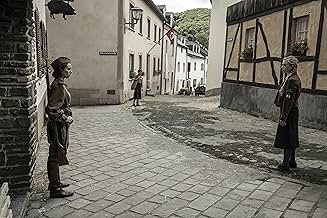PUNTUACIÓN EN IMDb
6,0/10
513
TU PUNTUACIÓN
En 1945, un tren de prisioneros judíos queda atascado cerca de un pueblo alemán ocupado por el Ejército Rojo. En medio de la desconfianza y la desesperación, desarrollan una amistad.En 1945, un tren de prisioneros judíos queda atascado cerca de un pueblo alemán ocupado por el Ejército Rojo. En medio de la desconfianza y la desesperación, desarrollan una amistad.En 1945, un tren de prisioneros judíos queda atascado cerca de un pueblo alemán ocupado por el Ejército Rojo. En medio de la desconfianza y la desesperación, desarrollan una amistad.
- Premios
- 1 premio y 3 nominaciones en total
Argumento
¿Sabías que...?
- PifiasWhen Vera brings a bottle of vodka and food to share with Winnie and the Jewish girl, the bottle has a metal screw cap, that was actually invented later, in the 60's.
Reseña destacada
The lost transport is a new war drama directed and written by Saskia Diesing, director of Nena en Dorst.
In the spring of 1945, a train with a hundred Jewish prisoners stranded near a small German village that had just been taken over by the Russians. The Dutch Jew Simone (Hanna van Vliet) tries to care for her sick husband and receives help from the Russian shredder Vera (Eugénie Anselin), whom she manages to hide in the house of the German maid Winnie (Anna Bachmann). The opposites now have to keep it together in the same place until the Americans can provide real security.
The story of the film is told in a mosaic fashion where each character has their own story, sometimes overlapping with each other. Despite these overlaps, the stories seem more detached from each other. This gives you three different stories to follow side by side. Because of this way of narration, the film can sometimes seem a bit unclear or it can sometimes be difficult to understand everything clearly.
At one moment the characters help each other, but at the next moment they can also betray each other and wish each other death, only to suddenly help each other again later. For example, the film sometimes remains somewhat implausible, when the mutual problems are suddenly quickly resolved without any real understandable consequences. Furthermore, the characters sometimes make illogical decisions, which are sometimes not always well worked out. Director Saskia Diesing could have looked a little closer at the details, because sometimes certain things don't match the time the story takes place in, which can also cause the film to lose some of its credibility.
Because of this less writing, the actors do not always come across clearly. The different characters from different countries also continue to speak their mother tongue, but the characters often know how to understand each other and also know how to negotiate nicely with each other. The background stories of all three main characters are also not all equally well developed. As a result, some decisions that are made sometimes remain difficult to understand.
In the spring of 1945, a train with a hundred Jewish prisoners stranded near a small German village that had just been taken over by the Russians. The Dutch Jew Simone (Hanna van Vliet) tries to care for her sick husband and receives help from the Russian shredder Vera (Eugénie Anselin), whom she manages to hide in the house of the German maid Winnie (Anna Bachmann). The opposites now have to keep it together in the same place until the Americans can provide real security.
The story of the film is told in a mosaic fashion where each character has their own story, sometimes overlapping with each other. Despite these overlaps, the stories seem more detached from each other. This gives you three different stories to follow side by side. Because of this way of narration, the film can sometimes seem a bit unclear or it can sometimes be difficult to understand everything clearly.
At one moment the characters help each other, but at the next moment they can also betray each other and wish each other death, only to suddenly help each other again later. For example, the film sometimes remains somewhat implausible, when the mutual problems are suddenly quickly resolved without any real understandable consequences. Furthermore, the characters sometimes make illogical decisions, which are sometimes not always well worked out. Director Saskia Diesing could have looked a little closer at the details, because sometimes certain things don't match the time the story takes place in, which can also cause the film to lose some of its credibility.
Because of this less writing, the actors do not always come across clearly. The different characters from different countries also continue to speak their mother tongue, but the characters often know how to understand each other and also know how to negotiate nicely with each other. The background stories of all three main characters are also not all equally well developed. As a result, some decisions that are made sometimes remain difficult to understand.
- movieman6-413-929510
- 20 abr 2023
- Enlace permanente
Selecciones populares
Inicia sesión para calificar y añadir a tu lista para recibir recomendaciones personalizadas
- How long is Lost Transport?Con tecnología de Alexa
Detalles
- Fecha de lanzamiento
- Países de origen
- Sitios oficiales
- Idiomas
- Títulos en diferentes países
- 1945: Tres dones
- Localizaciones del rodaje
- Fond-de-Gras, Differdange, Luxemburgo(the train is at standstill in the woods near a German village)
- Empresas productoras
- Ver más compañías en los créditos en IMDbPro
Taquilla
- Recaudación en todo el mundo
- 146.026 US$
- Duración1 hora 40 minutos
- Color
- Relación de aspecto
- 2.39:1
Contribuir a esta página
Sugerir un cambio o añadir el contenido que falta

Principal laguna de datos
What is the English language plot outline for 1945: tres mujeres (2022)?
Responde




























